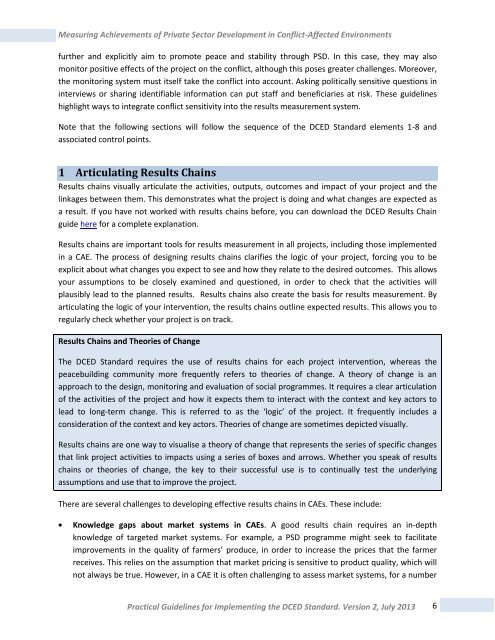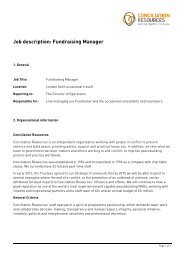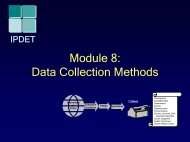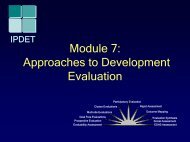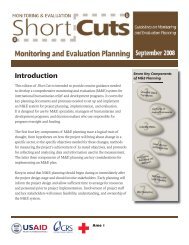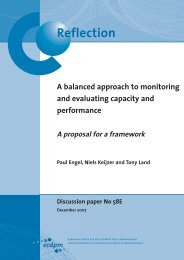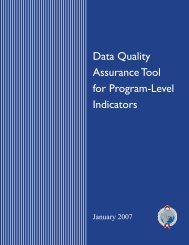Measuring Achievements of Private Sector Development in ... - DCED
Measuring Achievements of Private Sector Development in ... - DCED
Measuring Achievements of Private Sector Development in ... - DCED
You also want an ePaper? Increase the reach of your titles
YUMPU automatically turns print PDFs into web optimized ePapers that Google loves.
<strong>Measur<strong>in</strong>g</strong> <strong>Achievements</strong> <strong>of</strong> <strong>Private</strong> <strong>Sector</strong> <strong>Development</strong> <strong>in</strong> Conflict-Affected Environments<br />
further and explicitly aim to promote peace and stability through PSD. In this case, they may also<br />
monitor positive effects <strong>of</strong> the project on the conflict, although this poses greater challenges. Moreover,<br />
the monitor<strong>in</strong>g system must itself take the conflict <strong>in</strong>to account. Ask<strong>in</strong>g politically sensitive questions <strong>in</strong><br />
<strong>in</strong>terviews or shar<strong>in</strong>g identifiable <strong>in</strong>formation can put staff and beneficiaries at risk. These guidel<strong>in</strong>es<br />
highlight ways to <strong>in</strong>tegrate conflict sensitivity <strong>in</strong>to the results measurement system.<br />
Note that the follow<strong>in</strong>g sections will follow the sequence <strong>of</strong> the <strong>DCED</strong> Standard elements 1-8 and<br />
associated control po<strong>in</strong>ts.<br />
1 Articulat<strong>in</strong>g Results Cha<strong>in</strong>s<br />
Results cha<strong>in</strong>s visually articulate the activities, outputs, outcomes and impact <strong>of</strong> your project and the<br />
l<strong>in</strong>kages between them. This demonstrates what the project is do<strong>in</strong>g and what changes are expected as<br />
a result. If you have not worked with results cha<strong>in</strong>s before, you can download the <strong>DCED</strong> Results Cha<strong>in</strong><br />
guide here for a complete explanation.<br />
Results cha<strong>in</strong>s are important tools for results measurement <strong>in</strong> all projects, <strong>in</strong>clud<strong>in</strong>g those implemented<br />
<strong>in</strong> a CAE. The process <strong>of</strong> design<strong>in</strong>g results cha<strong>in</strong>s clarifies the logic <strong>of</strong> your project, forc<strong>in</strong>g you to be<br />
explicit about what changes you expect to see and how they relate to the desired outcomes. This allows<br />
your assumptions to be closely exam<strong>in</strong>ed and questioned, <strong>in</strong> order to check that the activities will<br />
plausibly lead to the planned results. Results cha<strong>in</strong>s also create the basis for results measurement. By<br />
articulat<strong>in</strong>g the logic <strong>of</strong> your <strong>in</strong>tervention, the results cha<strong>in</strong>s outl<strong>in</strong>e expected results. This allows you to<br />
regularly check whether your project is on track.<br />
Results Cha<strong>in</strong>s and Theories <strong>of</strong> Change<br />
The <strong>DCED</strong> Standard requires the use <strong>of</strong> results cha<strong>in</strong>s for each project <strong>in</strong>tervention, whereas the<br />
peacebuild<strong>in</strong>g community more frequently refers to theories <strong>of</strong> change. A theory <strong>of</strong> change is an<br />
approach to the design, monitor<strong>in</strong>g and evaluation <strong>of</strong> social programmes. It requires a clear articulation<br />
<strong>of</strong> the activities <strong>of</strong> the project and how it expects them to <strong>in</strong>teract with the context and key actors to<br />
lead to long-term change. This is referred to as the ‘logic’ <strong>of</strong> the project. It frequently <strong>in</strong>cludes a<br />
consideration <strong>of</strong> the context and key actors. Theories <strong>of</strong> change are sometimes depicted visually.<br />
Results cha<strong>in</strong>s are one way to visualise a theory <strong>of</strong> change that represents the series <strong>of</strong> specific changes<br />
that l<strong>in</strong>k project activities to impacts us<strong>in</strong>g a series <strong>of</strong> boxes and arrows. Whether you speak <strong>of</strong> results<br />
cha<strong>in</strong>s or theories <strong>of</strong> change, the key to their successful use is to cont<strong>in</strong>ually test the underly<strong>in</strong>g<br />
assumptions and use that to improve the project.<br />
There are several challenges to develop<strong>in</strong>g effective results cha<strong>in</strong>s <strong>in</strong> CAEs. These <strong>in</strong>clude:<br />
Knowledge gaps about market systems <strong>in</strong> CAEs. A good results cha<strong>in</strong> requires an <strong>in</strong>-depth<br />
knowledge <strong>of</strong> targeted market systems. For example, a PSD programme might seek to facilitate<br />
improvements <strong>in</strong> the quality <strong>of</strong> farmers’ produce, <strong>in</strong> order to <strong>in</strong>crease the prices that the farmer<br />
receives. This relies on the assumption that market pric<strong>in</strong>g is sensitive to product quality, which will<br />
not always be true. However, <strong>in</strong> a CAE it is <strong>of</strong>ten challeng<strong>in</strong>g to assess market systems, for a number<br />
Practical Guidel<strong>in</strong>es for Implement<strong>in</strong>g the <strong>DCED</strong> Standard. Version 2, July 2013<br />
6


